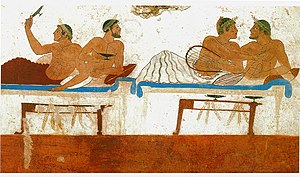Perjantanan di Yunani Kuno
Perjantanan di Yunani kuno adalah hubungan sosial yang diakui antara orang dewasa dan seorang laki-laki yang lebih muda biasanya yang masih di usia remaja.[1] Ini adalah karakteristik dari Kuno dan periode Klasik.[2] Beberapa ahli menemukan asal-usulnya dalam ritual inisiasi, terutama ritus peralihan di Kreta, di mana dikaitkan dengan pintu masuk ke dalam kehidupan militer dan agama Zeus.[3]

Terminologi
Asal mula
Aspek sosial
Aspek politik
Pandangan filosofis
Dalam seni
Praktek seksual
Konvensi puitis
Dalam mitos dan agama
Karakteristik regional
Yunani timur
Sparta
Megara
Athena
Boeotia
Pengetahuan modern
Referensi
- ^ C.D.C. Reeve, Plato on Love: Lysis, Symposium, Phaedrus, Alcibiades with Selections from Republic and Laws (Hackett, 2006), p. xxi online; Martti Nissinen, Homoeroticism in the Biblical World: A Historical Perspective, translated by Kirsi Stjerna (Augsburg Fortress, 1998, 2004), p. 57 online; Nigel Blake et al., Education in an Age of Nihilism (Routledge, 2000), p. 183 online.
- ^ Nissinen, Homoeroticism in the Biblical World, p. 57; William Armstrong Percy III, "Reconsiderations about Greek Homosexualities," in Same–Sex Desire and Love in Greco-Roman Antiquity and in the Classical Tradition of the West (Binghamton: Haworth, 2005), p. 17. Sexual variety, not excluding paiderastia, was characteristic of the Hellenistic era; see Peter Green, "Sex and Classical Literature," in Classical Bearings: Interpreting Ancient Culture and History (University of California Press, 1989, 1998), p. 146 online.
- ^ Robert B. Koehl, "The Chieftain Cup and a Minoan Rite of Passage," Journal of Hellenic Studies 106 (1986) 99–110, with a survey of the relevant scholarship including that of Arthur Evans (p. 100) and others such as H. Jeanmaire and R.F. Willetts (pp. 104–105); Deborah Kamen, "The Life Cycle in Archaic Greece," in The Cambridge Companion to Archaic Greece (Cambridge University Press, 2007), pp. 91–92. Kenneth Dover, a pioneer in the study of Greek homosexuality, rejects the initiation theory of origin; see "Greek Homosexuality and Initiation," in Que(e)rying Religion: A Critical Anthology (Continuum, 1997), pp. 19–38. For Dover, it seems, the argument that Greek paiderastia as a social custom was related to rites of passage constitutes a denial of homosexuality as natural or innate; this may be to overstate or misrepresent what the initiatory theorists have said. The initiatory theory does not claim to account for the existence of homosexuality, but for formal paiderastia.
Daftar pustaka
- Dover, Kenneth J. Greek Homosexuality. Duckworth 1978.
- Dover, Kenneth J. "Greek Homosexuality and Initiation." In Que(e)rying Religion: A Critical Anthology. Continuum, 1997, pp. 19–38.
- Ellis, Havelock. Studies in the Psychology of Sex, vol. 2: Sexual Inversion. Project Gutenberg text
- Ferrari, Gloria. FIgures of Speech: Men and Maidens in Ancient Greece. University of Chicago Press, 2002.
- Hubbard, Thomas K. Homosexuality in Greece and Rome. University of California Press, 2003.[1]
- Johnson, Marguerite, and Ryan, Terry. Sexuality in Greek and Roman Society and Literature: A Sourcebook. Routledge, 2005.
- Lear, Andrew, and Eva Cantarella. Images of Ancient Greek Pederasty: Boys Were Their Gods. Routledge, 2008. ISBN 978-0415223676.
- Nussbaum, Martha. Sex and Social Justice. Oxford University Press, 1999.
- Percy, William A. Pederasty and Pedagogy in Archaic Greece. University of Illinois Press, 1996.
- Same–Sex Desire and Love in Greco-Roman Antiquity and in the Classical Tradition of the West. Binghamton: Haworth, 2005.
- Sergent, Bernard. Homosexuality in Greek Myth. Beacon Press, 1986.